Gas is great. But, you never want to run out when on your caravan or motorhome holidays!
Hands up who hasn’t run out of gas at the most inopportune moment? Maybe when you’re partway through cooking a meal in your caravan or motorhome kitchen, or on the barbecue. Or if you’re relying on solely on gas for your leisure vehicle heating, on a particularly cold night (or, indeed, day). Or if you’re taking a shower, even.
In this video, we look at several ways of checking gas bottle levels in a caravan or motorhome to avoid these inconvenient moments!
Methods of checking how much gas you have left start as basic as lifting and shaking the cylinder (you’ll be able to hear the contents as well as, with experience, to gauge for yourself how much is in there) right through to sophisticated measuring systems.
One of the simpler and more scientific ways of accurately checking how much gas is in a metal cylinder is to pour hot water down the side. Safely disconnect and remove the gas cylinder from your leisure vehicle and pour hot water down the side of the gas cylinder. After a moment you should start to see a line of condensation form on the gas cylinder, which indicates the level of gas.
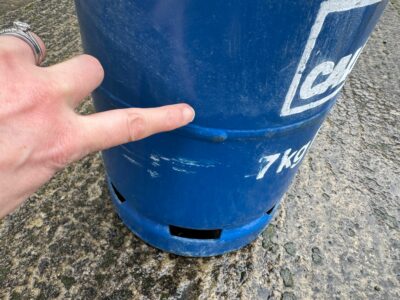
You can also use your hand to detect where the temperature of the cylinder turns from warmer to colder. You can work out the practicalities of that for yourselves, but it’s otherwise very accurate.
A more mathematical approach is to weigh the gas cylinder. Propane and Butane gas bottles have an aluminium disc around the collar showing the empty weight of the bottle – sometimes called the Tare weight.
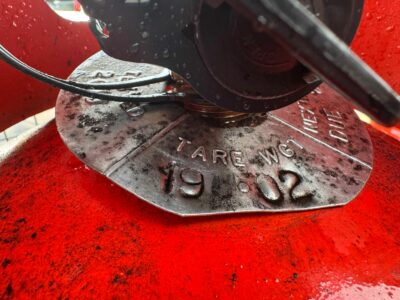
If you add the tare weight to the weight of the bottle you will get the weight of a full bottle of gas. In our example we had a 7kg bottle of gas with a tare weight of 18lb 10oz (8.45kg) meaning the full bottle weight was 15.45kg. Using a set of scales we weighed the gas cyclinder and it showed 12.5kg. Taking this away from 15.45kg meant we had 2.95kg of the gas has been used so we had just under 58% of our seven kilograms of gas left.
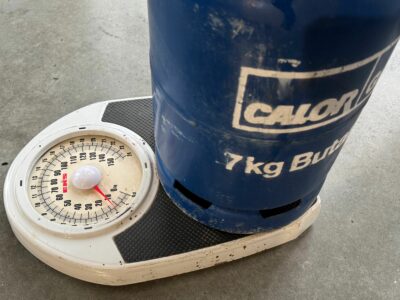
A low-price alternative is a self-adhesive strip, performing a similar function. However, feedback suggests these don’t always work too well.
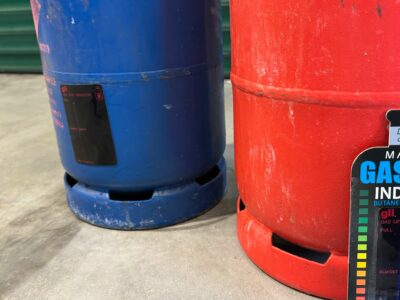
Or you could add an inline gauge which measures pressure to give a rough estimate of gas left. Otherwise, see our brief guide to gas level checking products below.
Top gas tips
- Verifying the safe working of your gas system forms part of the annual habitation service of your caravan or motorhome. Nevertheless, if you smell gas – and/or any gas rings burn with an orange colour rather than blue – do get things checked out.
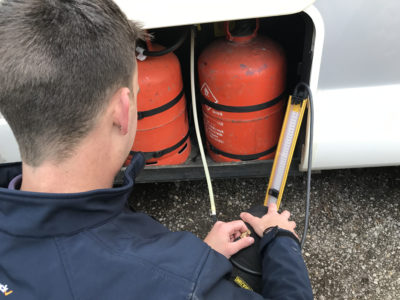
- Where space allows, why not consider using one large gas cylinder and one much smaller, for emergency back-up.
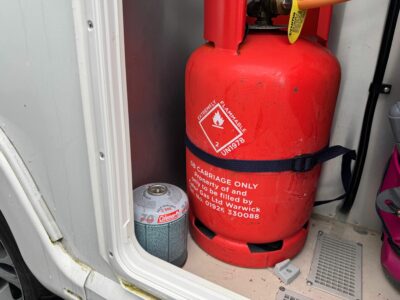
- If you use a lot of gas, you might want to consider moving to a system of on-board cylinder(s) that can be refilled by you. Gaslow is the most popular system of this type – its systems include gas level gauges.
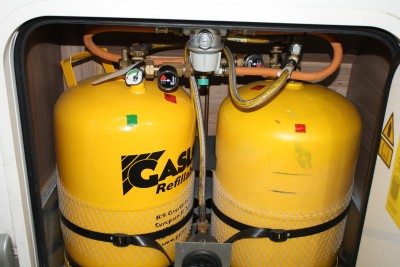
- A refillable gas cylinder also means you can reduce the weight in your caravan or motorhome by carrying just one gas cylinder and topping up as you travel.
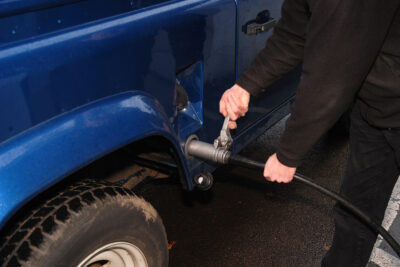
- Part of the reason for having a proper gas locker in your leisure vehicle is so you can travel with cylinder(s) safely secured. It’s not advisable to travel with loose gas cylinders or storing them anything other than upright.
- See more tips in our all about gas for caravans and motorhomes article.
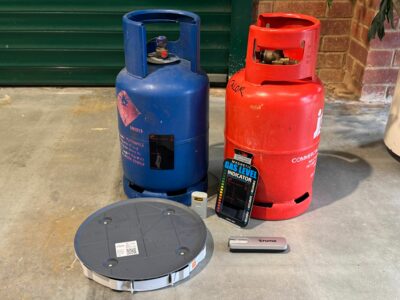
There are lots of devices to help you keep tabs on your gas levels – that’s if you’re not using a refillable cylinder. Let’s take a look…
Star Player #1
Truma LevelControl
A big investment, for sure. But the Truma LevelControl device magnetically fixes to the bottom of your cylinder and uses ultra-sound to detect the gas level inside.
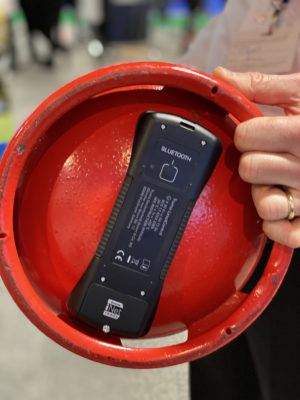
With the LevelControl App, you can then get the latest information sent to your mobile phone or tablet via Bluetooth. It will even calculate how many days of gas you have left, based on your usage.
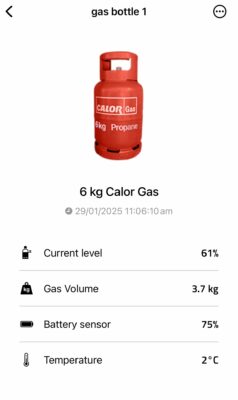
If you have Truma’s iNet box already fitted to your caravan or motorhome (you can buy the LevelControl and iNet box as a package for around £275) text alerts will let you know when your gas is getting too low – plus you can control your heating or air conditioning from miles away as well as check on your gas levels.
Key features Suitable for steel or aluminium propane cylinders, works between -15degC and 40degC, can be used on two-cylinder set-ups
Just be sure to remember to remove the LevelControl device from the bottom of your existing cylinder when swapping to a new one!
Expect to pay £164.09
Also see our video, where Jonathan from Truma talks through the features of the Truma LevelControl LPG gas level checking device.
Star Player #2
W8 Gas Control system
This is an electronic scale you can leave in situ under your gas cylinder, so it can constantly monitor gas usage – transmitting information to your smartphone or tablet via Bluetooth and a downloadable, free app.
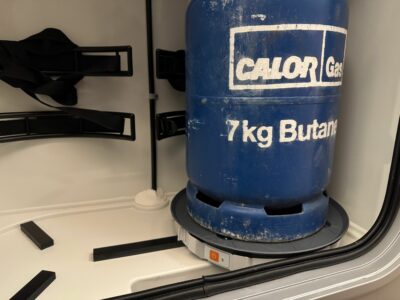
Just make sure you have sufficient height in your gas locker to accommodate this and your gas bottle. Its dimensions are 3.5cm high, 31cm diameter.
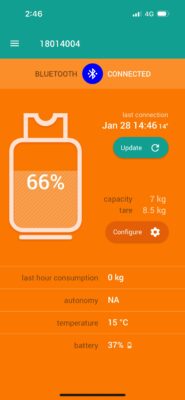
Key features Polypropylene shell, metal base plate, self-install, uses AA batteries, compatible with android and iOS systems
Expect to pay £87.99
Star Player #3
Dometic GasChecker GC100
Not much bigger than a pen, this uses ultra sound to detect the gas level in the cylinder.
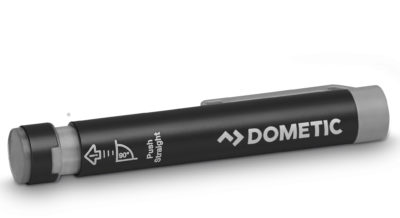
Its application depends on getting the angle (90 degrees) exactly right between the cylinder and the GasChecker. You run the the GasChecker down the side of your gas bottle and its indicator light turns from red to green when you reach the top of the gas level.
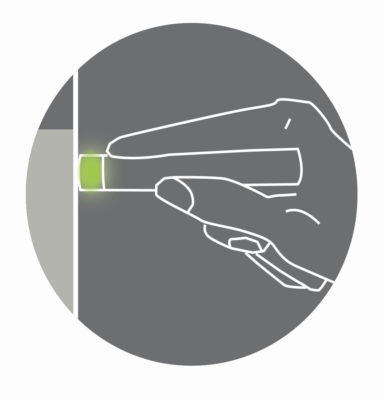
Key features Can be used on steel and aluminium cylinders, handy size, convenient to use
Expect to pay £73
Star Player #4
Truma GasLevel Check
Another pen style gas level checking device which uses ultrasound to show where the gas level is in the cylinder. By pushing the device onto your gas cylinder it will indicate red where no gas is present or green where it is.
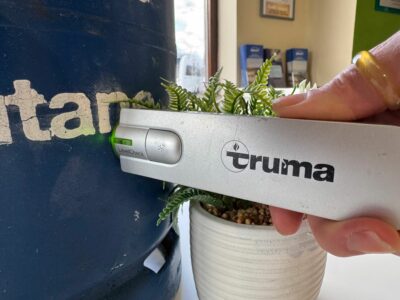
Key features Suitable for all steel and aluminium LPG cylinders with diameters of 200 to 350mm. Small, handy size.
Expect to pay £74.52
Star Player #5
Mopeka Pro Check Sensor
Similar to the Truma LevelControl this device magnetically attaches to the base of your gas cylinder. It uses ultrasonic sensing to measure the capacity of your gas bottle and can send alerts and readings via Bluetooth to your mobile phone or tablet device through the Tank Check app. You can set the type of gas, size of container and low level alarms.
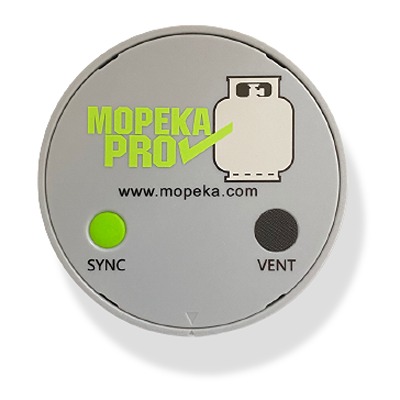
Key features Suitable for steel propane cylinders, updates every three seconds, programmable alerts
Expect to pay £84
Star Player #6
GasStop
An inline gauge for propane cylinders that also serves other purposes but it does have a gauge to show an approximate gas level. GasStop is designed to automatically shut-off should there be a major gas leak, and can also be used to test for smaller leaks.
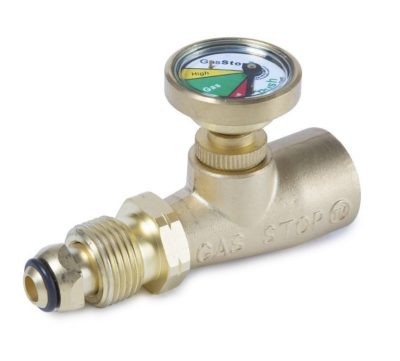
The company also says every GasStop valve leaving its factory is individually tested.
Key features Easy installation, operates between -20degC and 55degC, five-year warranty
Expect to pay £45
Over to you…
Got any advice on gas level checking you’d like to share with other caravan or motorhome owners? Please feel free to add a comment below.


Did I miss hear or did the presenter say “gamping cas”?
John
Yes, I’m afraid you did John. I couldn’t get my teeth in that day!!
Very good article and some useful hints and tips….. We carry two 6kg propane cyclinders and did run out after one empty cyclinder was replaced. The refil had the tap leak and this was not obvious at the time until the one being used ran out and at switch over…… the leaking one was empty.. The leak was so slow that I could not detect any small of gas.. luckily we were at a campsite that had a stock of Calor gas and this has made me very cautious now of checking the gas cylinders by the bathroom scales method of weighing them.. Looking at the Trauma device I may invest in one of those as it would save the hassle of removing the bottles before each trip away.
A very useful article, however, you haven’t included the simple and cheap method that I use – a digital luggage weight guage; costs less than £20.
Method: Read the bottle weight from the info on the bottle, subtract that value from the weight guage value, and there you have it. Simple.
As said above, Much easier if you use Safe Fill bottles as you can see the level of gas through the spun glass fibre.
Also much cheaper to refill at around £1.10 per litre (Morrisons)
Interesting article. Is there anything similar relating to Underslung gas tanks?
A pressure guage is next to useless for LPG as the “L” stands for “liquified”. The pressure above the liquid will remain constant (ie the Saturated Vapour pressure of the gas at that temperature) until all the liquid is exhausted/has vapourised, after which the cylinder is effectively empty!!
The Gas Genie is next door to useless as the magnets fall off without even moving the van. Even with a bungy around the tank to secure it I’m not sure it works.
I to have the Safefill bottles, fairly easy to see how much gas is left and of course they are VERY light in weight. Saving quite a bit on your payload.
Thank you! Lots of ideas and very practical .
We use 2 refillable gas cylinders. These are permanently strapped in for safety. During the summer when the gas is used for hot water, cooking and running the fridge as we do a lot of wild camping, one bottle tends to last 12-14 days. We always use the bottle at the front first and when that runs we normally refill after swapping over to the other cylinder. We have never had a problem and we do have the adaptors. The upfront cost pays for itself in about 50 complete refills of one cylinder. The peace of mind from being able to avoid running out is free
Interesting and informative article, but you can’t beat having two bottles as soon as one runs out, get it filled at the first opportunity, stick a lable on the empty bottle, so you dont forget to refill it
New to campervaning and find all suggested a great help even if it makes you just think of how much planning is required before setting off, so thanks to all. Bob.
Very helpful, thank you.
How about just weighing it? Use a luggage scale, easy, record weight when new, you can monitor how much you use on average and plan accordingly for next trip. Works for us. Can’t own it, tip came from my brother who also gave me the scale!
We have always carried two cylinders in our campers and for years I have always fitted a gas low gauge to the system, its useless for telling how much gas is in the system but brilliant for testing for gas leaks, simply keep a check on the dial for fifteen minutes after closing the gas bottle valve, if the needle stays at full there are no significant leaks.
Good. Interesting & Informative.
Many great idea’s if you carry only one cylinder, whilst I know there is more weight we have always carried 2 cylinders (12kg) as we like the quiet places these are not easy to buy a refill of gas. On the other hand more sites are stocking gas so don’t panic Mr Mannering.
One bottle you early touched on but didn’t quite is the safefill refillable bottle. These are made of a clear resin with a plastic surround so you can see into the bottle. When the bottle is in the locker, it is hard to see the lpg inside. I find using a torch (i use the one on my phone) held right up against the bottle and give the bottle a little wiggle is enough to see the lpg moving around.
I like your idea of pouring warm water over the bottle to see where the level is on a steel bottle. I would advise not to do this in the gas locker in case it causes damp in the floor.
In the early 2000’s I had an elddis which came with a built in ultra sound detector which lived under one bottle and had the gauge inside the caravan. It wasn’t very accurate at all but technology has moved on since then.
Great article with devices I have never heard of before.
The self adhesive strip is often a magnetic temperature gauge panel, but it really only works on butane not propane, because it gets colder than propane as it evaporates. They only really work when the gas has been used continuously for sometime. I got one that is useless on propane but works on butane. However most caravans use propane because butane freezes in low temperatures!
On a separate subject how annoying is the recall of the Calor light cylinders? I carry two 6kg capacity cylinders and the Calor Light oners were a godsend, saving about 3kg on each.
The review should have included real time uses by selected caravan users. I will test any of the products without prejudice and send my findings to you this season.l am a retired professionally qualified engineer and a caravan owner.
I use a Safefill cylinder and can see the exact level as it has translucent panels.